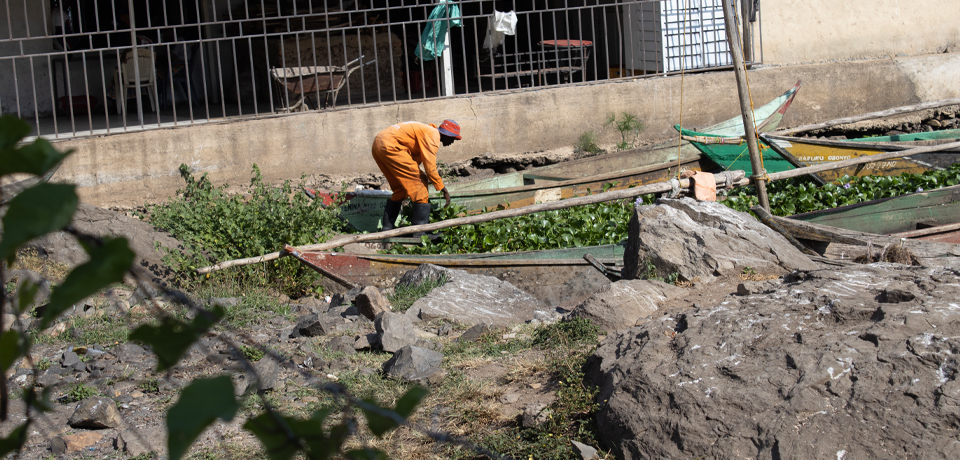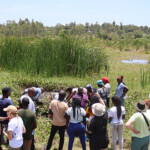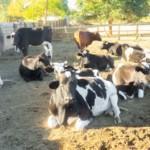
John Ngoka Ngala, Bazil Ebsiy Maikah, Maurice Simiyu, Alexandra Pennanen-Kok, Fahad Luta & Satu Määttänen
Sustainable supply and usage of affordable and clean energy is crucial for rural development, and for achieving many of the United Nations Sustainable Development goals. Yet, in Sub-Saharan Africa (SSA), many countries are still struggling to attain energy security. Around 759 million people globally lack access to electricity, and out of these three quarters live in SSA (IEA et al., 2022). Most households in SSA rely on forests for their energy needs, in the form of firewood and charcoal. Heavy dependency on forest biomass for energy leads not only to deforestation and forest degradation (Ritchie & Roser, 2021) that accelerate climate change, but also to the loss of valuable time resource used for firewood collection (Lambe et al., 2015). In addition, the use of wood and charcoal for cooking in open fire exposes to harmful air pollution that can cause respiratory diseases and even premature death (WHO, 2014).
Population increase, industrialization and urbanization increase the pressure on the energy supply globally. This precipitates the need to innovate and transform into a modern, clean and sustainable renewable energy supply and usage. Biofuels can offer a sustainable energy source for developing countries to become self-dependent at the domestic level (Mitchell, 2010). Biofuels are fuels obtained from plant-based materials (Saini et al., 2015).
This article scrutinizes water hyacinth’s potential as feedstock for sustainable cooking biofuel in Kenyan rural areas around Lake Victoria, through literature and surveys conducted to key value chain stakeholders.
Water hyacinth as a source of bioethanol around Lake Victoria
Water hyacinth (Eichhornia crassipes), a hydro plant, has spread from its native environment of the Brazilian Amazon to freshwater lakes in SSA. In Lake Victoria, water hyacinth was first reported in 1895 (Nyawacha et al., 2021). Since then, it has become a harmful invasive species that is rapidly spreading in the lake (Nyawacha et al., 2021). The water hyacinth layer on the water hampers casting fishing nets, and the decomposition of the dead plants depletes the water’s dissolved oxygen content, decreases the clarity of the water, and results in an obnoxious odor (Degaga, 2018). The changes in the water ecosystem caused by water hyacinth can lead to a dwindling quantity of native species, such as fish (Nyawacha et al., 2021). The eutrophication of Lake Victoria, caused by anthropogenic pollution from agricultural lands and industries further promotes the growth of water hyacinth (Nyawacha et al., 2021). Attempts to remove water hyacinth from the lake, through chemical treatments and manual removal have proven to be futile (Güereña et al., 2015).
Although a menace in water bodies, such as Lake Victoria, water hyacinth, due to its abundant availability and high cellulose and hemicellulose content, is a potential feedstock to produce bioethanol for household consumption, especially for cooking purposes (Adegoke et al., 2021; Wang et al., 2019).
For producing bioethanol, the water hyacinth stems are used. The leaves and roots are not suitable for processing due to their low cellulose content (Bušić et al., 2018). The stems are milled to produce a pulp from which the lignin is removed. The mixture is hydrolyzed and fermented, and after that, the bioethanol water mixture is separated from the solid residue and distilled to achieve a suitable fuel concentration of 96 w/v%, which is ready for packaging and distribution (Bušić et al., 2018).
Water hyacinth removal for bioethanol production can lead to a win-win situation with the provision of clean energy and restored water ecosystems. In addition, water hyacinth does not compete for land with food crops, such as many other biofuel feedstocks (Tudge et al., 2021; Wang et al., 2019).
For Kenya, water hyacinth-based bioethanol can be one of the solutions for the country’s energy shortage (Moss & Gleave, 2013) by increasing the energy supply to better meet domestic demand. Simultaneously, it can provide an environmentally friendly alternative to firewood, charcoal and fossil fuels. Yet, the biofuel cooking usage rate in Kenya is currently very low, due to the high prices of the fuel cooking stoves (CCAK et al., 2019). Other factors leading to low fuel stove usage are a limited supply of bioethanol, inappropriate design of the stoves, and lack of awareness of biofuel by the local population (CCAK et al., 2019).
Water hyacinth-based bioethanol value chain
The analysis of the water hyacinth bioethanol value chain (VC) of CIST Africa, the main water hyacinth-based bioethanol processor in Kenya, identified different actors, processes, policies and challenges (Figure 1).

Water hyacinth is mostly harvested by freelancer youths, coordinated by beach managers, within the informal sector. The harvesters face challenges such as tediousness of manual harvesting and inefficiencies in the remuneration strategy. Most harvesters desire payments according to working hours, while CIST Africa, the main processor of water hyacinth to bioethanol in the area, opts for payments per kilogram harvested to reduce costs.
CIST Africa is targeting to scale up its bioethanol processing and production, but it is constrained by a lack of access to knowledge and technology and a lack of proper policies regulating bioethanol production. Currently, CIST Africa produces 1500 liters of bioethanol from water hyacinth daily, corresponding to estimated 6750 hours of cooking (Oketch et al., 2014). The seasonality of water hyacinth, attributed to its movement with water currents, requires proper storage techniques and has resulted in CIST Africa exploring alternative feedstock such as molasses and sugar beet to meet the production demand of bioethanol.
Last Mile entrepreneurs, a marketing company, is responsible for marketing bioethanol to customers. Yet the restricted supply, caused by the low processing capacity from CIST Africa, limits market base expansion.
The main end consumers of water hyacinth-based bioethanol are Kakuma Refugee Camp and local households in Western Kenya. Consumer demand for and adoption of bioethanol is limited by the high prices of biofuel cooking stoves, and by the consumer’s experience that bioethanol can only be used for cooking meals with short preparation time, thus being not an efficient alternative to firewood, kerosene, and charcoal. For increased adoption and usage of water hyacinth-based bioethanol, the stove prices should be reduced and the design improved, as also suggested by CCAK et al. (2019).
At a meso level, the VC analysis identified different institutions such as the Energy and Petroleum Regulatory Authority, Clean Cooking Association of Kenya, Kenya Industrial Research and Development Institute, Egerton University, Maseno University, and National Environment Trust Fund that provide support in research, policy regulations and standards in regards of the water hyacinth bioethanol value chain.
Conclusions
Bioethanol processed from water hyacinth is a potential renewable and clean energy source that can, at least partly, replace firewood and charcoal usage and dependency in domestic levels in Kenya. Not only mitigating deforestation and forest degradation associated to firewood and charcoal usage, harvesting and processing water hyacinth to bioethanol can contribute to restoring the Lake Victoria’s ecosystem and alleviate energy security challenges in the region.
For wide scale benefits and utilization of water hyacinth-based bioethanol, the VC needs to be further developed. For social sustainability, sufficient income for, and well-being of harvesters must be guaranteed. The processor’s intellectual and physical capacity need to be enhanced for ensuring continuous and stable supply for retailers. Awareness should be promoted among potential bioethanol consumers, and affordable and efficient stove models designed to enhance adoption. For developing and improving the water hyacinth VC, collaboration among financial and research institutions, government and non-governmental organizations would be crucial to enable knowledge-based approach and benefits for all VC actors.
Authors
John Ngoka Ngala, Department of Food Science and Postharvest Technology, Faculty of Agriculture and Environment, Gulu University, Uganda.
Bazil Ebsiy Maikah, Department of Biosystems Engineering, Faculty of Agriculture and Environment, Gulu University, Uganda.
Maurice Simiyu, Department of Agricultural Economics and Agribusiness, Faculty of Agriculture, Egerton University, Kenya.
Alexandra Pennanen-Kok, Department Culture and Arts in Smart and Sustainable Design, Häme University of Applied Sciences, Finland.
Fahad Luta, Department of Agricultural Economics and Agribusiness, Faculty of Agriculture, Egerton University, Kenya.
Satu Määttänen, M.Sc. in Agricultural Sciences and M.Sc. in Environmental Science and Policy from the University of Helsinki. She works as a Research Assistant at Häme University of Applied Sciences in HAMK Bio Research Unit, Finland.
References
Adegoke, S. O., Adeleke, A. A., Pelumi, P., Nnodim, C. T., Balogun, A. O., Falode, O. A., Adetona, S. O., Oluwafikayo, S., Adeleke, A. A., & Pelumi, P. (2021). Energy from biomass and plastics recycling : a review. Cogent Engineering, 8(1). https://doi.org/10.1080/23311916.2021.1994106
Bušić, A., Mardetko, N., Kundas, S., Morzak, G., Belskaya, H., Šantek, M. I., Komes, D., Novak, S., & Šantek, B. (2018). Bioethanol Production from Renewable Raw Materials and Its Separation and Purification: A Review. Food Technology and Biotechnology, 56(3), 289–311. https://doi.org/10.17113/FTB.56.03.18.5546
CCAK, Ministry of Energy (Kenya), SNV, RVO, Practical Action, & GIZ. (2019). Kenya Cooking Sector Study: Assessment of the Supply and Demand of Cooking Solutions at the Household Level. https://www.fao.org/forestry/energy/catalogue/search/detail/en/c/1306942/
Degaga, A. H. (2018). Water Hyacinth (Eichhornia crassipes) Biology and its Impacts on Ecosystem, Biodiversity, Economy and Human Well-being. Journal of Life Science and Biomedicine, 8(6), 94–100.
Güereña, D., Neufeldt, H., Berazneva, J., & Duby, S. (2015). Water hyacinth control in Lake Victoria: Transforming an ecological catastrophe into economic, social, and environmental benefits. Sustainable Production and Consumption, 3, 59–69. https://doi.org/10.1016/J.SPC.2015.06.003
IEA, IRENA, UNSD, World Bank, & WHO. (2022). Tracking SDG 7: The Energy Progress Report. https://trackingsdg7.esmap.org/
Lambe, F., Jürisoo, M., Wanjiru, H., & Senyagwa, J. (2015). Bringing clean, safe, affordable cooking energy to households across Africa: an agenda for action. http://newclimateeconomy.report/misc/working-papers
Mitchell, D. (2010). Biofuels in Africa : opportunities, prospects, and challenges. https://documents.worldbank.org/en/publication/documents-reports/documentdetail/617361468201837240/biofuels-in-africa-opportunities-prospects-and-challenges
Moss, T., & Gleave, M. (2013). How Much Power Does Africa Really Need? Center for Global Development. https://www.cgdev.org/blog/how-much-power-does-power-africa-really-need
Nyawacha, S. O., Meta, V., & Osio, A. (2021). Spatial Temporal Mapping of Spread of Water Hyacinth in Winum Gulf, Lake Victoria. The International Archives of the Photogrammetry, Remote Sensing and Spatial Information Sciences, XLIII–B3–2(B3-2021), 341–346. https://doi.org/10.5194/ISPRS-ARCHIVES-XLIII-B3-2021-341-2021
Oketch, P. O., Ndiritu, H. M., & Gathitu, B. B. (2014). Experimental Study of Fuel Efficiency and Emissions Comparison from Bio-ethanol Gel Stoves. Proceedings of the 2014 Sustainable Research and Innovation Conference, 72–78. https://sri.jkuat.ac.ke/jkuatsri/index.php/sri/article/view/42
Ritchie, H., & Roser, M. (2021). Forests and Deforestation. Our World in Data. https://ourworldindata.org/forests-and-deforestation
Saini, J. K., Saini, R., & Tewari, L. (2015). Lignocellulosic agriculture wastes as biomass feedstocks for second-generation bioethanol production: concepts and recent developments. 3 Biotech, 5(4), 337–353. https://doi.org/10.1007/S13205-014-0246-5/TABLES/8
Tudge, S. J., Purvis, A., & De Palma, A. (2021). The impacts of biofuel crops on local biodiversity: a global synthesis. Biodiversity and Conservation, 30, 2863–2883. https://doi.org/10.1007/S10531-021-02232-5
Wang, Z., Zheng, F., & Xue, S. (2019). The Economic Feasibility of the Valorization of Water Hyacinth for Bioethanol Production. Sustainability, 11(3), 905. https://doi.org/10.3390/SU11030905
WHO. (2014). WHO Guidelines for indoor air quality: Household fuel combustion. https://www.who.int/publications/i/item/9789241548885





